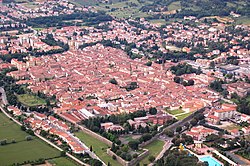Sansepolcro | |
|---|---|
| Città di Sansepolcro | |
 Aerial view of Sansepolcro. | |
| Coordinates: 43°34′15″N 12°08′25″E / 43.57083°N 12.14028°E | |
| Country | Italy |
| Region | Tuscany |
| Province | Arezzo (AR) |
| Frazioni | Aboca, Gragnano, Gricignano, Melello, Montagna, Santa Fiora |
| Government | |
| • Mayor | Fabrizio Innocenti |
| Area | |
| • Total | 91.48 km2 (35.32 sq mi) |
| Elevation | 330 m (1,080 ft) |
| Population (31 December 2014)[2] | |
| • Total | 16,012 |
| • Density | 180/km2 (450/sq mi) |
| Demonym | Biturgensi - Borghesi |
| Time zone | UTC+1 (CET) |
| • Summer (DST) | UTC+2 (CEST) |
| Postal code | 52037 |
| Dialing code | 0575 |
| Patron saint | St. John the Evangelist |
| Saint day | December 27 |
| Website | www.comune.sansepolcro.ar.it |
Sansepolcro, formerly Borgo Santo Sepolcro, is a town and comune founded in the 11th century, located in the Italian Province of Arezzo in the eastern part of the region of Tuscany.
Situated on the upper reaches of the Tiber river, the town is the birthplace of the painters Piero della Francesca, Raffaellino del Colle (a pupil of Raphael), Matteo di Giovanni, Santi di Tito, and Angiolo Tricca. It was also the birthplace of the Italian mathematician Luca Pacioli, and of Matteo Cioni, who translated Piero della Francesca's treatise about perspective in painting (De prospectiva pingendi) into Latin.
Today, the economy of the town is based on agriculture, industrial manufacturing, food processing and pharmaceuticals. It is the home of Buitoni pasta, founded by Giulia Buitoni in 1827.
- ^ "Superficie di Comuni Province e Regioni italiane al 9 ottobre 2011". Italian National Institute of Statistics. Retrieved 16 March 2019.
- ^ "Popolazione Residente al 1° Gennaio 2018". Italian National Institute of Statistics. Retrieved 16 March 2019.


